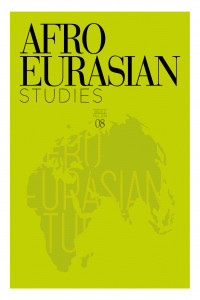"Dini Değerlere Yönelik Değersizleştirme” ve Şiddet: Hindistan’da Kimlik, Politika ve Sih Ayrılıkçılığı.
Sih dini, Hindistan’da Hinduizm ve İslam’ın gölgesinde ortaya çıktı. Kendisini “Hinduizm”den uzak ayrı bir kategori olarak şekillendirdi. O dönemin Müslüman Hükümdarları Sihizm’in etkisini kontrol altına almaya çalışırken, 19. ve 20. yüzyıllarda Hindu seçkinleri Sihleri asimile etmeye çalışmıştır ve onlara Hinduizm içinde bir mezhep muamelesi yapmıştır. Bu makale, Sihizm’in kendine özgü kimliğini koruma ve asimilasyon girişimlerine direnme arayışının haritasını çıkarmaya çalışmaktadır. Hindistan’daki Khalistan hareketi veya Sih ayrılıkçılığı da ayrı bir kimliği koruma ve asimilasyona direnme girişimidir. Aşağılama genellikle şiddetin doğrudan nedeni olarak tanımlanmıştır. Ancak bu makale, şiddetin bir nedeni olarak “Dini Değerleri Değersizleştirme” kavramını ve ayrıca onun “döngüsel doğasını” incelemeye çalışacaktır. Makale, dini değerleri değersizleştirme ve şiddeti birbirinin hem öncülü hem de emsali olarak sunacak ve böylece birbirini besleyecektir.
Anahtar Kelimeler:
Dini Değersizleştirme, Şiddet, Sihizm, Kimlik ve Politika
“Religious Humiliation” and Violence: Identity, Politics and Sikh separatism in India
Sikh religion originated under the shade of Hinduism and Islam in India. It shaped itself as a distinct category away from “Hinduism”. While the Muslim Rulers of that era tried to contain the influence of Sikhism, the Hindu elites in the 19th and 20th centuries tried to assimilate Sikhs and treated them as a sect within Hinduism. This paper tries to map the quest of Sikhism for maintaining its distinct identity and resisting attempts of assimilation. The Khalistan movement or the Sikh separatism in India is also an attempt to maintain a distinct identity and resist assimilation. Humiliation has been often identified as the immediate cause of violence. This paper will however try to probe the specific notion of “Religious Humiliation” as a cause of violence and also its “cyclic nature”. The paper would present humiliation and violence as both antecedents as well as precedents of each other, thereby feeding into each other. The khalistan movement framed and located its identity in militant Sikhism, encompassing a mythical glorious past, a collective decline, and the urge to rise up.
___
- Anderson, B. (1983). Imagined communities. London: Verso Books.
- Chima, Jugdep S. The Sikh Separatist Insurgency in India: Political Leadership and Ethnonationalist Movements. New Delhi: SAGE Publications India Pvt Ltd, 2010. http://dx.doi.org/10.4135/9788132105381.
- Fazal, T. (2014). ‘Nation-state’ and Minority Rights in India: Comparative Perspectives on Muslim and Sikh Identities. Oxon, New York: Routledge.
- Grewal, J. S. (1998) a. The Sikhs of the Punjab (Vol. 2). United Kingdom: Cambridge University Press.
- Grewal, J. S. (2011) b. Four Centuries of Sikh Tradition: History, Literature, and Identity. New Delhi: Oxford University Press.
- Grewal, J. S., & Banga, I. (1999). History and Ideology: The Khalsa Over 300 Years. New Delhi: Virago Press.
- Guha, R. (2007). India After Gandhi: The History of the World’s Largest Democracy. London: Macmillan Harter, S., Low, S. M., & Whitesell, N. R. (2003). What have we learned from Columbine: The impact of the self-system on suicidal and violent ideation among adolescents. Journal of School Violence, 2, 3–26. doi:10.1300/J202v02n03_02
- Mahmood, C. K. (2000) a.Trials by fire: Dynamics of terror in Punjab and Kashmir. In (Ed.) Death squad: The anthropology of state terror, University of Penn- sylvania Press.
- Mahmood, C. K. (2010) b. Fighting for faith and nation: Dialogues with Sikh militants. Philadelphia: University of Pennsylvania Press
- Pettigrew, J. (1995). The Sikhs of the Punjab: Unheard voices of state and guerilla violence, The University of Michigan: Zed Books.
- Shaffer, R. (2012). The Sikh Separatist Insurgency in India: Political Lead- ership and Ethnonationalist Movements, Thousand Oak: Sage Publications.
- Singh, J. (2011). Khalistan struggle: a non-movement. New Delhi: Aakar Books.
- Singh, K. (2004).a A History of the Sikhs: 1839-2004 (Vol. 1). New Delhi: Oxford University Press.
- Singh, K. (2004).b A History of the Sikhs: 1839-2004 (Vol. 2), New Delhi: Oxford University Press.
- Smith, D. (2004). Trends and causes of armed conflict. In (Ed.) Transform- ing Ethnopolitical Conflict, Obersalzberg: Berghof Research Center for Constructive Conflict Management, 111-127.
- Staniland, P. (2014). Networks of rebellion: Explaining insurgent cohesion and collapse. Cornell: Cornell University Press. Stewart, F. (2012). Religion versus ethnicity as a source of mobilization: Are there differences?In (Ed.) Understanding Collective Political Violence, London: Palgrave Macmillan, 196-221.
- Torres, W. J., & Bergner, R. M. (2012). Severe public humiliation: Its nature, consequences, and clinical treatment. Psychotherapy, 49, 492–501.
- Walker, J., & Knauer, V. (2011). Humiliation, self-esteem, and violence. Journal of Forensic Psychiatry and Psychology, 22, 724– 741.
- ISSN: 2147-110X
- Yayın Aralığı: Yıllık
- Başlangıç: 2012
- Yayıncı: Musiad (Independent Industrialists and Businessmen's Association)
